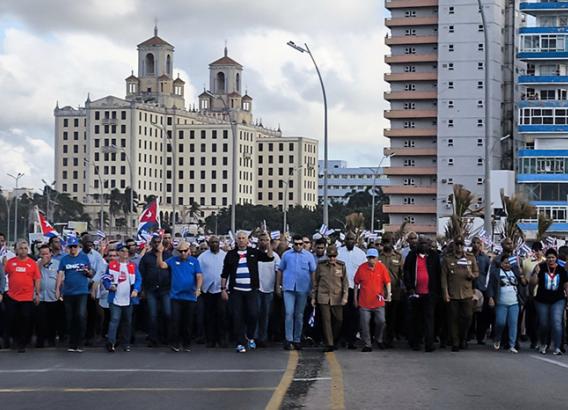Ambient Fear: The U.S. and the enemy at home syndrome
especiales

Very prominently, old concerns have gained renewed momentum in this century in the U.S. The perceptions of threat to the nation, which influence both collective consciousness and public opinion as well as government reports and academic works are among the main ones. These ideas fuel presidential campaigns and partisan agendas. Promises and proposals are formulated in the face of such concerns or expectations, feeding speeches and electoral platforms. The 2024 presidential race, already underway, is paying attention to the issue, which will increase in the coming months.
Rooted for historical reasons as symbols in the national imagination during the 20th century, in which their expressions are manifested with different legal scope, such unease affects today both the civil society and the political system. They are spread through traditional media and new digital social networks. Exclusionary visions are regained, which criminalize immigrants and encourage their rejection, labeling them as harmful to the nation. In artistic and literary culture, especially in cinema, these stereotypes are also expressed. Discrimination, racism and xenophobia gain space, with fascist overtones, by presenting them as internal threats to national identity and security. This makes up the enemy at home syndrome.
Precisely in this context this matter is stirred up. On December 18th, coinciding with International Migrant Day, in Texas, what is considered the toughest anti-immigrant law in the United States was enacted. Signed by the state governor, who has stated that the current situation on the border represents “a risk to national security,” it allows the authorities to detain and initiate deportation procedures for those who arrive illegally —with Mexicans as the main issuers, but not the only ones— to their territories. Previously approved the previous month by the local Republican legislative majority, it will come into force in March next year, and includes greater funds for the construction or reinforcement of the wall, initiated by Trump. It is a clear conservative message, in one of the most populated states, and made up of more than 40% Hispanics. It targets Democrats and migrants, projecting itself very critically against Biden and longing for his predecessor, who has expressed that, if he regains the presidency, he will resume his intolerant fight.
Once again, in North American history, immigration is placed at the epicenter of a cultural framework that is shaped around negative perceptions of the “other.” The immigrant’s image is presented as that of a dangerous entity, whose language, customs, religious beliefs and political ideas contaminate society, which is why it must be the target of social, legal control and repression. The strength and reproduction of this gaze “of the other” has shaped an ideology of fear, which permeates the culture, by installing in daily life a symptomatology of siege on North American society, which emerges intermittently in its recent period. This is not, of course, a new phenomenon, although the pattern of prejudice and intolerance that sustains it is manifested more strongly in the present century. This happened in its first decade, that of 2000, under the tenure of George W. Bush, and also in the second, that of 2010, especially in its last stage, that of Donald Trump. This has to do with the very fact that immigration to the United States has grown exponentially, especially irregular immigration, since the last decades of the last century. Hence, the reactions of intransigence and fanatical white supremacy come together in a sociopolitical and cultural environment of rejection. This situation is very visible in the anti-immigrant sentiment, widespread in North American society, palpable in practical expressions in the conservative sectors of the social movement and parties. In its midst, the immigrant is considered a threat to domestic national security and American cultural identity, with Latin Americans and Arabs in the front row.
Although with Trump it gained further notoriety, there was already a political discourse and even a presidential action, which placed the label of marginal individuals, delinquents, criminals, drug traffickers, drug addicts, alcoholics and prostitutes, on the population from other countries, from Latin America, particularly from Mexico. Those from the Middle East are labeled as terrorists, especially those from the Muslim world.
Even in recent times, and even with a benevolent, demagogic rhetoric that appeared to defend the immigrant, a similar trend had already been revealed with the Barack Obama’s Administration, attributing to him the largest number of deportations of Mexicans and other Latin Americans in the recent history of the United States. Among other, more distant antecedents, it is worth remembering the promulgation of anti-immigrant laws influenced by the anti-communist hysteria of the Cold War, such as McCarran-Walter Act, in 1952, which limited the access of immigrants classified as undesirable, establishing restrictive measures, which alluded to security reasons. Also, under the shadow of the Conservative Revolution, the Simpson-Rodino Act, in 1987, referring to the arrival of illegal immigrants from Latin America, which imposed, for the first time in North American history, sanctions (fines and even prison), to those who hired undocumented immigrants. And, within the framework of neoliberal globalization, in 1994, the so-called Proposition 187 prohibited undocumented immigrants from accessing public health and education, among other social services.
The fear and rejection of immigrants has been, to a certain extent, the heritage of the two electoral parties and the accompanying political thought. In certain situations, partisan and even ideological similarities in the treatment of the issue have been evident, as they have been shared, although not in the same way, by Republicans and Democrats, by conservatives and liberals. The perception of immigration, as a symbol of the enemy at home, which constituted a threat to identity, has thus remained located in the American imagination, with a reinforced perspective. The point is that identity embraces concepts of inclusion and exclusion: to be "us" (that is, Americans) we need "others" (Latin Americans, Arabs), who when crossing borders bring with them “the different”, the “pollutant." Thus, one lives in the midst of fear. One breathes, socially, in an environment defined by an ambient fear.
The diversity that has characterized the population of the United States for some thirty years is revealed dramatically from the 1990 census data, when it was found that one in every four Americans belonged to one of the so-called largest minorities, the Latin American, and predicted that over time such demographic diversity would increase considerably, due on the one hand to the slow growth of the majority white population, and on the other, to the rapid growth of Asian and Latino minorities, with skin colors, facial features, customs and different languages.
The above fosters an environment marked by fear of the “other,” which augmented soon after the crisis created in September 2001 by the terrorist attacks on the Twin Towers and the Pentagon. Against this backdrop, under the current Administration of Joseph Biden, now in his last year, a cultural symbolism persists based on representations that make the immigrant and those who profess religious affiliations considered strange, an alleged threat to national security and identity, before which the real party will compete in toughness. It is about facing the enemy at home.
*Professor and researcher at the University of Havana.
Translated by Sergio A. Paneque Díaz / CubaSí Translation Staff













Add new comment